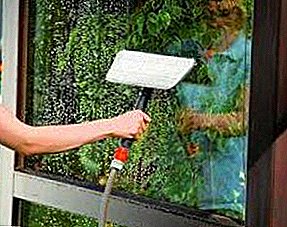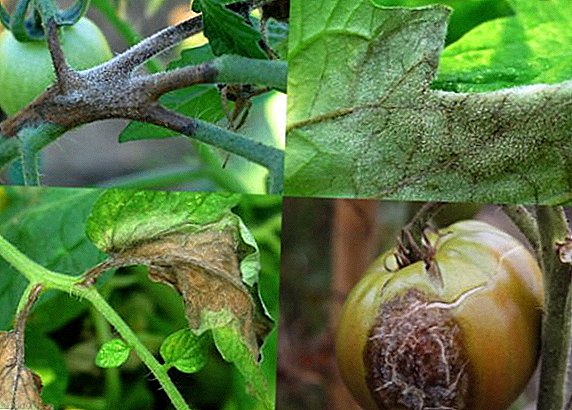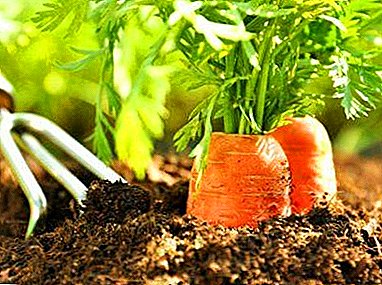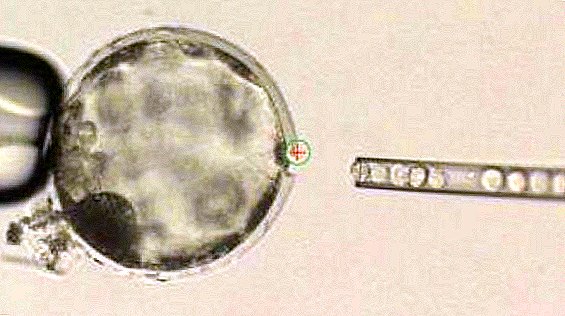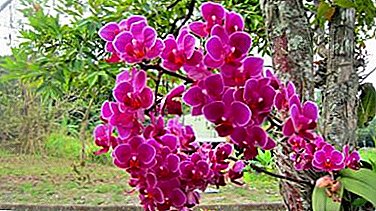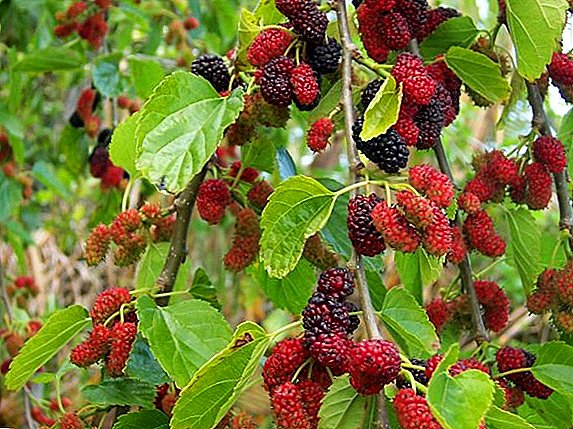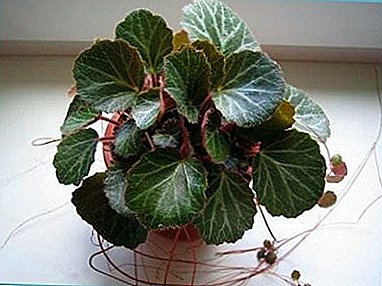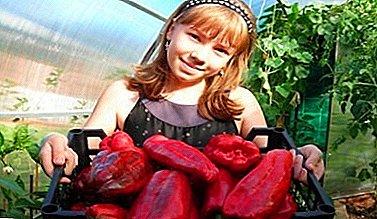
Sweet pepper is one of the most popular vegetables among gardeners.
Despite its South American origin, the plant has been successfully cultivated in many regions of our country.
General description of the plant
One of the most delicious and large hybrid varieties is Kakadu Pepper with a ripening ripening period: 95-110 days pass from germination to fruiting. Sprawling bush, up to 1.5 m.
The bright red shiny fruits of the plant are large, elongated-cylindrical in shape, weighing up to 0.5 kg, with thick fleshy flesh with a thickness of 6-10 mm. It has a high immunity to pests and diseases. Productivity in open ground - up to 3.5 kg / m², in protected - up to 12.
We also recommend that you familiarize yourself with the best varieties of sweet pepper, which are described here, and from this article you will learn about the nine most interesting species of this plant.
A photo
The photo shows Kakadu pepper:


Plant Care
Planting seeds
The optimal time for planting seeds of this vegetable is the second half of March and the beginning of April. The soil mixture for pepper is prepared in advance by taking it from the beds in the garden plot, in which the cultures of the cepe family were not cultivated.
Important! The soil for growing this plant should be fertile, loose and breathable.
Pepper seeds are sown in wooden boxes, plastic or peat cups to a depth of 1.5-2 cm at a temperature of 25-28 ºС.
The first shoots of the vegetable appear on the 7-10 day, after which the seedlings are exposed to a bright and cool place.
Growing seedlings
When a young sprout of one or two true leaves appears in the young shoots, they are transplanted into separate containers with a third root removed. This technique is called a pick. It is produced in 2-3 weeks after the emergence of the plant shoots.
Important! A few days after transplanting pepper seedlings should be protected from direct sunlight, after which they are placed in a bright and cool place.
 With the normal development of vegetable seedlings, fertilizing is not required. If the plants grow poorly, have lost color, then they make mineral complex fertilizers.
With the normal development of vegetable seedlings, fertilizing is not required. If the plants grow poorly, have lost color, then they make mineral complex fertilizers.
Not only south windows, but also east and west window sills are ideal for accommodating young pepper seedlings.
Plants are watered as the substrate dries with warm snow or settled tap water in the morning and afternoon.
Transplantation in open ground
In the southern areas, plant seedlings are planted in open ground in the second half of May and early June., and in the north - 1-2 weeks later.
For planting vegetables prefer elevated and sunny places. If garden soil is heavy and poor (for example, forest or sandy), then rotten manure or compost is brought into it - a bucket for 1.5-2 m² of land and wood ash - 0.5 l / m².
Dig up the soil and arrange the beds in which the peppers are planted in a two-row pattern. The distance between the bushes "Kakadu" in the row should be 40-50 cm, and between them - at least one meter. The high density of planting leads to the development of diseases and lower yields.
Fertilizer
For feeding plants use both complex mineral and organic fertilizers.
The first time pepper fed up in 10-14 days after planting in open ground.
Urea is used, but chicken dung gives the best results, which is diluted with water at a ratio of 1:15 and insist in a warm place until the end of fermentation. The resulting solution is shed contour pristvolnoy wells.
 The second time feeding is made in the period of mass flowering and fruit set of the plant. Along with chicken manure use mullein.
The second time feeding is made in the period of mass flowering and fruit set of the plant. Along with chicken manure use mullein.
In the latter case, cow dung is mixed with water in a ratio of 1:10 and poured into the furrows made between the rows of pepper.
It is useful to spray the leaves and flower buds of the plant with an infusion of ash - 1-2 glasses per bucket of water.
The third dressing with liquid chicken manure is timed to the beginning of fruiting of the hybrid variety "Kakadu".
Watering
The frequency of irrigation - at least 1 time per week, and in the greenhouse - every 1-2 days.
After this procedure, the soil is loosened around the peppers, followed by mulching with turf ground or humus with the addition of wood ash.
Pruning shoots
For a good harvest, the Kakadu bush is formed at the seedling stage. When 5-6 true leaves appear, they pinch the upper point of growth, which leads to the development of lateral shoots, on which fruits mainly develop.
After planting peppers in the ground, the stepchildren forming in the interstitials must be cut off, leaving a stump of 2 cm in length.
Harvest
Crop harvested when the lower fruits of the "Kakadu" will get the maximum sizecharacteristic of this variety, however, will not reach biological ripeness.
Since the shoots of pepper are weak, the fruits of the plant are carefully removed along with the stem.
The collection is repeated every 4-5 days.
Seed breeding
 To get vegetable seeds choose a well-growing bush., leaving on it no more than 2-3 fruits in the third bottom tier, which can withstand up to the fullest possible ripening.
To get vegetable seeds choose a well-growing bush., leaving on it no more than 2-3 fruits in the third bottom tier, which can withstand up to the fullest possible ripening.
The remaining fruits and ovaries are removed at least 1 time per week.
When the testes reach biological ripeness, they are removed and put in paper bags until completely dry. Then the fruit of the pepper is cut, and the seeds are packaged in paper bags, indicating the name of the variety and the year.
Benefit
Decorative
Pepper carries not only a purely practical function, because its bushes are very decorative, and the presence of beautiful red fruits, immersed in bright greenery, is able to decorate any area.
Food
Interesting! Variety "Kakadu" is used as a food plant in salads, stewed, boiled and fried, as well as for stuffing and preservation.
Medicinal
The plant is considered by nutritionists and doctors as a source of many beneficial vitamins:
- provitamin A: an antioxidant that prevents aging of the body;
- Vitamin C: strengthens the immune system for colds and ARVI;
- Vitamin B: necessary for the normal functioning of various organs and body systems, especially nervous and digestive, improves the condition of the skin and hair, affects the links of immunity;
- Vitamin F: strengthens the walls of blood vessels, preventing hemorrhage;
- folic acid: beneficial for fetal development.
In addition, sweet pepper contains a lot of iron and potassium, which is useful in anemia and heart disease. Vegetable is also rich in fiber, which improves the digestive tract, normalizes metabolism and reduces the risk of cancer.
In cosmetology, fresh juice is valued as a moisturizing tonic, and plant gruel is in the form of a face mask.
Diseases and pests
Among the major diseases of "Kakadu" are the following:
Late blight
For the prevention of the disease, 10–15 days after landing in the ground, the vegetable is sprayed with a solution of Bordeaux mixture. Pepper treatment with such preparations as "Phytodoc" and "Oxy" is effective. With a strong defeat, apply Ridomil Gold, Barrier and Barrier.
Vertex fruit rot
For prevention, Kakadu seeds before planting are treated with a 0.25% solution of copper sulfate or potassium permanganate. Calcium nitrate spraying helps.
Pests
Aphid
 To eliminate pests, the vegetable is sprayed with a water extract of ash or tobacco.
To eliminate pests, the vegetable is sprayed with a water extract of ash or tobacco.
With the ineffectiveness of these measures apply rapidly decomposing insecticides: "Keltan" and "Karbofos."
The treatment is carried out in the morning until flowering, but not during the fruiting period.
Spider mite
From this scourge of pepper get rid of insecticidal drugs: "Fufanonom", "Karbofos", "Aktellik" and "Fosbecidom."
- Bogatyr
- Ramiro.
- Atlanta.
Choosing the variety "Kakadu", the gardener gets a hybrid, distinguished by high gastronomic qualities, resistance to diseases and pests, as well as simple farming techniques. The presence of a storehouse of vitamins and microelements in a plant helps to restore lost health and contributes to the prevention of many ailments.


